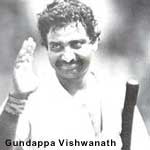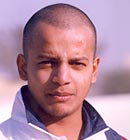Home > Cricket > Report
A brief history of the Irani Trophy
Mohandas Menon |
September 18, 2003 10:23 IST
The Irani Trophy tournament was conceived during the 1959-60 season to mark the completion of 25 years of the Ranji Trophy Championship and is named after the late Z R Irani, who was connected with the Board of Control for Cricket in India from its inception in 1928 till his death in 1970.
Before becoming president of the board from 1966 to 1969, Irani was the honorary treasurer (from 1948 to 1962), and one of the vice-presidents from 1963 to 1965.
 In appreciation of his services to Indian cricket, the BCCI instituted a trophy in his name, to be presented to the winners of a match to be played between the Ranji Trophy champions of the preceding year and a selected Rest of India XI.
In appreciation of his services to Indian cricket, the BCCI instituted a trophy in his name, to be presented to the winners of a match to be played between the Ranji Trophy champions of the preceding year and a selected Rest of India XI.
The first match of the series was played between Bombay and the Rest at the Ferozshah Kotla Ground in Delhi from March 18 to 20, 1960. Though the match was drawn, Bombay were declared winners by virtue of having gained the first innings lead.
The captain of the winning side, Polly Umrigar, has the distinction of scoring the first century of the tournament -- 102 in 137 mins with 14 fours. Gujarat off-spinner Jasu Patel, who had claimed 14 wickets against Australia at Kanpur just three months prior to this match, was the first to take a five-wicket haul (5-98 in 23 overs) for the Rest of India team. Interestingly, Rest of India's twelfth man Prem Bhatia was allowed to bat in the team's second innings in place of skipper Lala Amarnath.
 | Challenger Trophy 2003 |  | |
|
Rest of India's 757-7 declared against Bengal at Bangalore in 1990-91 is the highest score by a team in the tournament, while the 83 by the Rest against Bombay at Anantapur in 1963-64 is the lowest. (Bombay's highest is 566-5 declared at the Brabourne Stadium in 1962-63, while its lowest is 93 at the Wankhede Stadium in 1997-98).Pravin Amre's 246 for the Rest against Bengal at Bangalore in 1990-91 is the highest individual score for a batsman. (Ramnath Parkar's 195 at Pune in 1972-73 remains the best for Bombay.)
 Gundappa Vishwanath (playing for both Rest of India and Karnataka) has the distinction of being the only batsman in this series to aggregate more than 1,000 runs -- 1,001 runs (avg 77.00) in nine matches. Vishwanath also has the distinction of aggregating the most runs for the Rest of India team -- 594 (avg 74.25) in six matches. Ashok Mankad has made the most runs for Bombay -- 759 (avg. 33.00) in 13 matches.
Gundappa Vishwanath (playing for both Rest of India and Karnataka) has the distinction of being the only batsman in this series to aggregate more than 1,000 runs -- 1,001 runs (avg 77.00) in nine matches. Vishwanath also has the distinction of aggregating the most runs for the Rest of India team -- 594 (avg 74.25) in six matches. Ashok Mankad has made the most runs for Bombay -- 759 (avg. 33.00) in 13 matches.
Left-arm spinner Murali Kartik's 9-70 for the Rest of India against Mumbai at the Wankhede Stadium in 2000-01 are the best bowling figures, while another left-arm slow bowler, Ravi Shastri, representing Bombay, has the next best figures of 9-101 (at Indore in 1981-82).
Anil Kumble's 13-138 (for the Rest against Delhi at Delhi in 1992-93) are the best match-haul figures. Leggie Sairaj Bahutule's 13-168 at the Wankhede in 1997-98 are the best match figures for a Mumbai bowler.
 The 2003-04 encounter in Chennai will the 41st of the series. The Rest of India has won the Irani Trophy the most number of times, 16, followed by Bombay/Mumbai (15). (The title was shared by the Rest of India and Bombay in 1965-66 at the Corporation Stadium in Madras, as rain prevented a result even on first innings scores.) Karnataka (4), Delhi (2) and Hyderabad, Tamil Nadu, Haryana and Railways are the other teams to have laid their hands on the trophy.
The 2003-04 encounter in Chennai will the 41st of the series. The Rest of India has won the Irani Trophy the most number of times, 16, followed by Bombay/Mumbai (15). (The title was shared by the Rest of India and Bombay in 1965-66 at the Corporation Stadium in Madras, as rain prevented a result even on first innings scores.) Karnataka (4), Delhi (2) and Hyderabad, Tamil Nadu, Haryana and Railways are the other teams to have laid their hands on the trophy.
Incidentally, the only other Irani Trophy match at the Chepauk was played in October 1988, when the 1987-88 Ranji Trophy champions, Tamil Nadu, took on the Rest. It ended on a happy note for the home side when they won the match by three wickets (chasing a target of 340) and despite conceding a first innings lead of 207 runs. (The opponents did not enforce the follow-on.) The hero of the match was Tamil Nadu opener V B Chandrasekhar, who was dismissed first-ball in the first innings, but blasted 119 (in 123 mins, off just 78 balls, with eight sixes and 11 fours; the 100 coming off just 56 balls!) in the second.